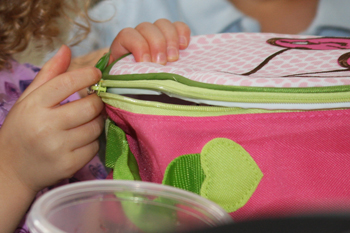The prepackaged lunch kits and snacks that often end up in children’s lunch boxes not only contain too much sugar, salt and fat, but they also can be quite expensive.
Most of the time, packing a healthier lunch can also save parents money.
One tip that can help curb the costs of packed lunches while boosting their nutritional quality is to remember to pack plenty of fruits and vegetables.
The United States Department of Agriculture’s MyPlate nutrition guidelines recommend that nearly half of every meal should be made up of fruit and vegetables.
Most kids love fruit, but vegetables may be a more challenging sell. Children will usually eat cut-up, raw carrots and celery, so why not add in some raw broccoli pieces, cauliflower or cherry tomatoes? Just one-half cup counts as a full serving of vegetables.
Add a low-fat dip made with low-fat ranch dressing mixed with an equal amount of nonfat plain yogurt, and your child will be happily chomping away. Also, many children enjoy homemade vegetable soup. Add some alphabet macaroni, and they will enjoy making words as they eat.
Fresh fruit is less expensive if you buy it in bags instead of by the piece. You can peel and section citrus fruits ahead of time for younger children and place them in reusable plastic containers or aluminum foil. It is better to have the child eat his or her fruit rather than drink juice since the fruit has more fiber. However, if you do send juice, buy the larger bottles of 100 percent juice and pour smaller portions into reusable juice boxes found at discount stores.
For many kids, a sandwich is the cornerstone of a well-packed lunch box.
Parents may find that building a scrumptious sandwich is less expensive if they buy a beef roast, ham or whole chicken and cook and slice it at home, instead of buying salty and expensive lunchmeat. This meat can easily be packaged in smaller portions to freeze until you need them.
If tuna salad is a favorite, parents can save some money by using store brands of mayonnaise and pickles. The constant crowd pleaser, peanut butter and jelly, can be made less expensively and more healthful by using your store’s brand of low-sugar fruit spread instead of regular jelly or jam.
Parents should always choose bread that is whole grain or at least multigrain. Again the least expensive loaves usually are store brands, but for variety, try whole wheat wraps, pita bread, English muffins or bagels. Some kids also like whole grain crackers with low-fat cheese instead of a sandwich.
Making extra of a favorite dinner dish, like baked ziti or macaroni, and sending it heated in a thermos for lunch the next day is also a good way to cut the cost of lunches. Sending leftovers saves time and money and ensures that you know how much fat and salt went into your child’s meal. For an extra nutritional kick, parents can add some cooked vegetables — either pureed in the sauce or just added to the dish — to sneak in an extra serving.
Plain nonfat or low-fat milk is the best beverage.
If your child insists on chocolate milk, make your own with chocolate powder. You can then control how much is added. Commercial chocolate milk has the equivalent of 3 added teaspoons of sugar. Yogurt is also a good substitute for milk. To save money, buy 32-ounce size containers and divide into smaller amounts.
Remember to keep cold food cold and hot food hot. Freeze the sandwiches and the milk, juice or yogurt to keep the entire lunch cold (they should thaw by noon) or use ice packs in the lunch box.








